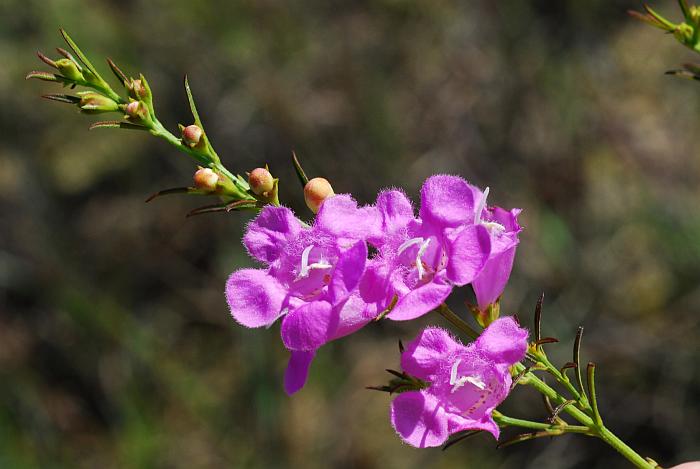Agalinis fasciculata (Elliott) Raf.
Fasiculate False Foxglove

Native
CC = 7
CW = 0
MOC = 18
© SRTurner
Agalinis fasciculata (Elliott) Raf.Fasiculate False Foxglove | |
 |
Native CC = 7 CW = 0 MOC = 18 |
© SRTurner |
|
Family - Orobanchaceae Habit - Annual forb, hemiparasitic, often lacking a well defined taproot. Stems - Erect, to 1 m, herbaceous but stout, terete near the base, angled in the apical half, scaberulous, puberulent, much-branched, mostly green.
Leaves - Opposite, linear, entire, antrorse strigose, acute, to 3 cm long, 1-1.5 mm broad, slightly folded, with well developed axillary fascicles. Fascicles similar in size to the subtending leaf.
Inflorescence - Axillary racemes in the upper 2/3 of the stem. Racemes very bracteate and the inflorescence appearing as just axillary flowers. Flowers single from each leaf (bract) axil, 1-2 per node, opposite. Pedicels 3-5 mm long, shorter than or equaling the calyx, glabrous, ascending. Axis of the inflorescence angled, puberulent.
Flowers - Corolla pink, to +2cm long, 5-lobed. Corolla tube densely antrorse pubescent externally, mostly glabrous internally, contracted in the basal 5mm (the portion surrounded by the calyx). Corolla tube with pink spots and two yellow stripes internally (ventrally). Corolla lobes rounded, with pilose margins, to 1 cm broad, 1 cm long, spreading, the upper two pilose-bearded at the base internally. Stamens 4, didynamous, mostly included. Filaments pale pink to whitish, pink pilose, to 1 cm long, adnate at the apex of the contracted portion of the corolla tube. Anthers whitish, pilose dorsally, 3 mm long, 1.5 mm broad, with two acute basal lobes. Style 1, exserted beyond the corolla and from between the stamens, pale purple basally, whitish at the apex, mostly glabrous and terete, flattened and puberulent on the margins in the apical 1/3 (the stigma). Ovary superior, green, glabrous, ovoid, to 2 mm long in flower, 2-locular, with many ovules. Placentation axile. Calyx campanulate, green, glabrous, 5mm long in flower, 5-lobed. Lobes 1-1.6 mm long, triangular-attenuate with a slight keel that somewhat ribs the calyx tube in the apical 1/2. Most dorsal calyx lobe slightly larger than the others.
Fruits - Globose, glabrous, 4.5-6.0 mm. Seeds 0.6-1.0 mm long, black to dark brown. Flowering - August - October. Habitat - Prairies, sandy open ground, thickets, woodland edges, fallow fields. Origin - Native to the U.S. Lookalikes - Other species of Agalinis. Other info. - This striking species can be found in Missouri mainly near the southwestern corner, with scattered populations in the southeast. The plant is more common in states to the south and east and extends up the east coast to Maryland. Missouri is near the northwestern extent of its range. It grows well in relatively poor, sandy soils. The plant can be identified by its big flowers (which have pink spots internally), and its linear leaves which have well developed axillary fascicles. Photographs taken off Lee Rd 10, Auburn, AL., 9-23-04; also at St. Joe State Park, St. Francois County, MO, 9-5-2018 (SRTurner). |